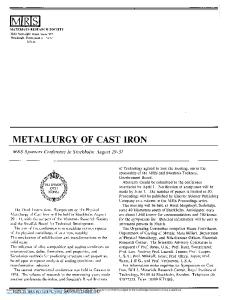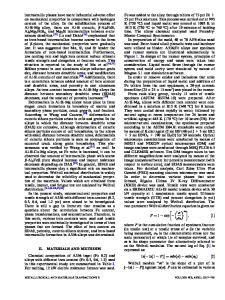Shallow Cryogenic Treatment (SCT) Effects on the Mechanical Properties of High Cr Cast Iron: Low-Carbon Cast Steel Bimet
- PDF / 3,838,115 Bytes
- 10 Pages / 595.276 x 790.866 pts Page_size
- 51 Downloads / 304 Views
Copyright Ó 2020 American Foundry Society https://doi.org/10.1007/s40962-020-00532-0
Abstract The shallow cryogenic (subzero) treatment (SCT) effect on the mechanical properties of the bimetallic casting used in the crushing industry has been investigated. Examination methods include sand casting, heat treatment and SCT, Charpy impact test, optical microscope, scanning electron microscope, microanalysis of the chemical composition (energy dispersive spectroscopy—EDS), x-ray diffraction, and hardness measurement. Two bimetallic castings (single casting containing two layers, one of low-carbon cast steelLCCS-back up part and other high Cr cast iron-HCCIworking part) have been prepared by the sand casting method. They have been subjected to diffusion annealing at 1040 °C for 5 h. One of them was quenched in pressurized
air till 100 °C and was tempered at 270 °C for 3 h and, and the other one has been subjected to SCT at - 84 °C for 24 h and then tempered at 270 °C for 3 h. The impact toughness values before and after SCT are determined five Charpy specimens per point. Hardness values and metallography of samples have been analyzed and compared. A remarkable change was observed in hardness and impact energy/toughness before and after SCT.
Introduction
In this technique, bimetallic castings are produced by two methods; first one is liquid–liquid casting and second one is liquid–solid (mold-cavity preparation) configuration.6,7 A preheat to the base part is needed before casting.8
In the crushing industry, abrasive wear resistant and durable castings are needed in great demand for crushers both in room temperature and in elevated temperatures. These components usually contain expensive materials such as Ni, Co, Ti, and Mo. The working surface layer is affected mostly; however, the whole casting consists of the same homogeneous expensive material component generally. So, a need is emerged for cheaper and more durable materials. Bimetallic castings fulfill this need.1 In a bimetallic casting, working surface (high alloy casting) is hard and wear resistant for long life duration, and the base material is tough and relatively soft in order to absorb impacts.2,3 Compared with classical high-Mn (Hadfield Steel Mn: %12, C: %1.2, Si: %0.5, Cr: %1,5 max. Fe:rest HB:460/ HRC:48) wear resistant castings, bimetallic casting have some advantages.4 They are harder and tougher, and they have longer life duration.5
International Journal of Metalcasting
Keywords: subzero (shallow) cryogenic treatment (SCT), bimetallic casting, hardness, charpy impact test, high Cr cast iron (HCCI), low-carbon cast steel (LCCS)
Academic studies on bimetallic castings technology are not widespread because of high-cost economic process of pouring two different alloys,2,3,5 the necessity of applying insert preheating8 and complicated casting process.2,3,5 Cryogenic treatment (CT), which is sometimes called cryogenic tempering, utilizes ultra-cold temperatures to modify the microstructure of metals and other materials. It has been widely adopted as a c
Data Loading...










